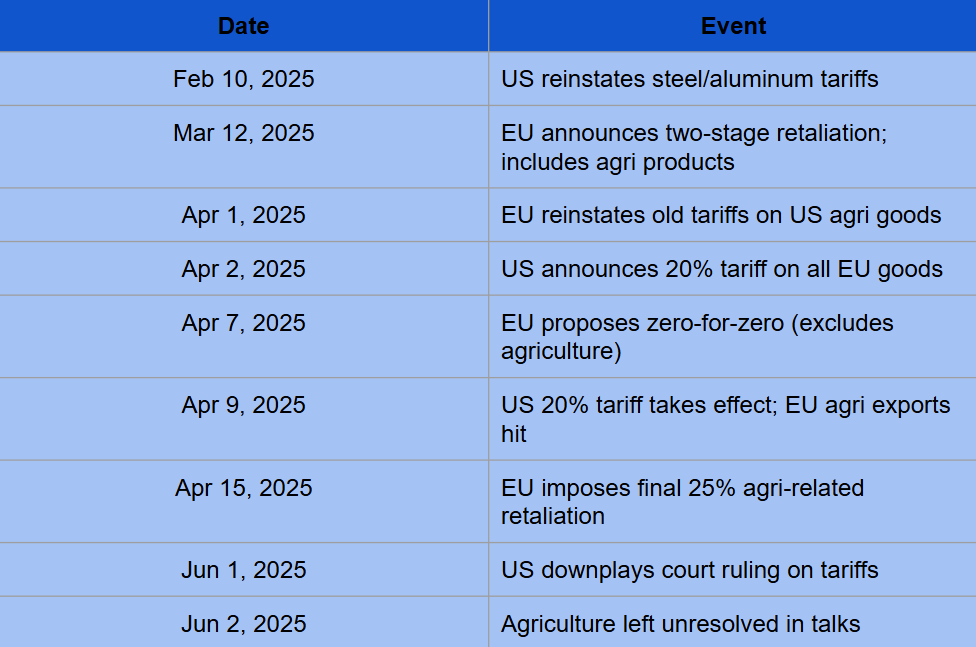2025 US-EU Tariff Standoff Deepens Agricultural Disruption, Triggers Global Supply Chain Realignments

As political posturing deepens and uncertainty grows, this article highlights how countries like Brazil are emerging as strategic winners, while U.S. and EU exporters recalibrate their market strategies under pressure. The long-term implications extend well beyond transatlantic trade, signaling a shift toward bloc-based trade alignments and new rules of engagement in global agrifood markets.
Escalating Trade Tensions Between the US and EU
The longstanding trade relationship between the United States (US) and the European Union (EU) has come under severe pressure in 2025, following an escalating trade standoff that shows no signs of letting up. What began as a renewed dispute over steel and aluminum tariffs has quickly evolved into a broader conflict, with agriculture emerging as one of the most severely affected sectors on both sides of the Atlantic.
On February 10, 2025, US President Donald Trump reinstated 25% tariffs on steel and aluminum imports from the EU, effectively revoking a quota-based compromise that had been in place since 2021. While the measure initially targeted industrial goods, it reopened longstanding tensions in the transatlantic trade relationship. This move prompted swift retaliation from Brussels.
In response, the European Commission (EC) unveiled a two-phase countermeasure plan. Phase one, effective April 1, reimposed tariffs that had been suspended following previous disputes in 2018 and 2020. Phase two, which came into force on April 15, introduced new 25% tariffs on EUR 21 billion worth of American exports, many of which were agricultural. Products such as soybeans, corn-based ethanol, tree nuts, whiskey, and processed foods were among the key targets. These categories were strategically chosen to exert political pressure on core agricultural regions in the US, reflecting a tactic employed during previous trade disputes under the Trump administration.
The US escalated the conflict further on April 2, imposing a blanket 20% tariff on all EU imports. This sweeping measure, which took effect on April 9, significantly impacted a broad array of European exports, particularly premium agri-food products. European producers of wine, cheese, olive oil, and confectionery now face higher costs and diminished competitiveness in the US market. On the other side, US importers and consumers are contending with price increases and reduced product variety, especially in the specialty food sector.
Figure 1. Timeline of US-EU Tariff Actions in 2025

EU Deepens Agricultural Trade Ties with Brazil
Amid this volatility, the EU has moved swiftly to diversify its trade relationships and reduce dependency on US agricultural exports. Brazil has emerged as a key alternative supplier, particularly for high-demand commodities like soybeans and corn. Trade data from 2024 illustrates this strategic pivot. Germany’s soybean imports from the US fell by 8.5% year-on-year (YoY) to 2.45 million metric tons (mmt), while soybean imports from Brazil surged 82.3% YoY, reaching 572,460 metric tons (mt). Italy followed a similar pattern, increasing its soybean imports from Brazil by 22.2% YoY to 1.42 mmt in 2024. This realignment reflects a broader recalibration of supply chains amid geopolitical uncertainty.
Figure 2. Soybean Imports from Brazil
.png)
To reinforce this shift, the European Council President visited Brazil from May 27 to 29, with official engagements occurring in Brasília and São Paulo. This visit marked a renewed political and economic alignment between the EU and Brazil, one of the EU’s most strategic agricultural partners. The visit focused on strengthening cooperation in sustainable agriculture, climate action, digital trade, and raw material security. It also came ahead of Brazil’s presidency of COP30 and builds momentum for implementing the EU-Mercosur trade agreement, the negotiations of which were concluded in Dec-24.
US Pistachio Exports Benefit from EU Focus Amid China Tensions
This escalating trade conflict also impacts American exporters of commodities such as tree nuts. For example, US pistachio suppliers aim to increase supply to the EU given the escalating tariff war between the US and China, which has seen the Chinese market become less accessible. According to Tridge data, Italy imported USD 32.63 million worth of pistachios (shelled) from the US in 2024, a 61.77% YoY increase. Similarly, Germany imported USD 32.07 million worth of pistachios (shelled) from the US, a 92.5% YoY increase. The case is similar for pistachios (in shell). Germany imported USD 262.88 million worth of US pistachios (in shell) in 2024, a 58.9% YoY increase, with Spain importing USD 106.06 million worth of US pistachios (in shell), 5.3% more than the previous year. As a result, greater focus on these markets could prove profitable for US suppliers. However, a resolution regarding the ongoing tariff standoff between the US and the EU would be required to facilitate trade.
Global Agricultural Supply Chains Undergo Structural Realignment
Globally, the conflict is accelerating shifts in agricultural supply chains. Countries are increasingly forming trade alignments along geopolitical lines, with blocs like the EU-Mercosur partnership gaining prominence. This transition is contributing to increased market volatility, particularly for staple commodities such as soybeans, corn, and processed foods. Moreover, both US and EU producers are beginning to consider nearshoring, regionalization, and supply chain localization strategies to hedge against future disruptions.
Outlook: Prolonged Uncertainty for Agricultural Trade
Despite renewed diplomatic efforts, including a new round of trade talks scheduled in Washington for early June, agriculture remains one of the most entrenched and politically sensitive issues in transatlantic trade. As negotiations proceed, stakeholders in the agriculture sector must prepare for prolonged instability through the remainder of 2025 and potentially beyond. With market access, production costs, and global competitiveness at stake, the current standoff is likely to reshape the structure of global agricultural trade for years to come.




